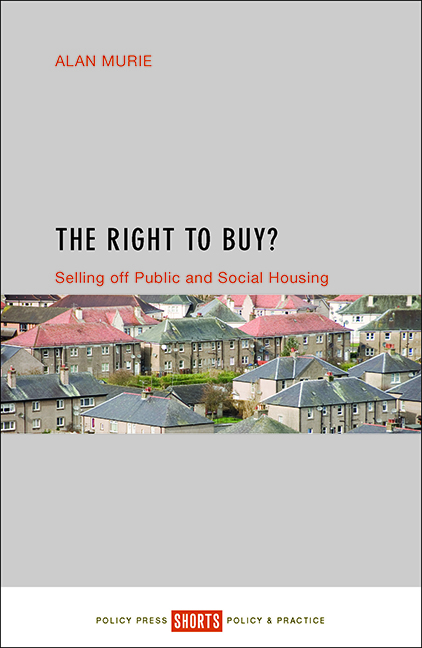Book contents
- Frontmatter
- Contents
- List of tables and figures
- About the author
- Acknowledgements
- 1 Introduction
- 2 Selling public housing: precursors and preconditions
- 3 A policy history of the Right to Buy, 1980-2015
- 4 Statistics and impacts of the Right to Buy
- 5 A policy commentary
- 6 The next phase: extending the Right to Buy in England
- 7 Conclusions: public and social housing: slow death or new beginnings?
- References
- Index
5 - A policy commentary
Published online by Cambridge University Press: 05 April 2022
- Frontmatter
- Contents
- List of tables and figures
- About the author
- Acknowledgements
- 1 Introduction
- 2 Selling public housing: precursors and preconditions
- 3 A policy history of the Right to Buy, 1980-2015
- 4 Statistics and impacts of the Right to Buy
- 5 A policy commentary
- 6 The next phase: extending the Right to Buy in England
- 7 Conclusions: public and social housing: slow death or new beginnings?
- References
- Index
Summary
Introduction
The Right to Buy was initially advantageous to long established tenants who had no plans to move, but as the policy matured and discounts increased, the properties sold and the tenants buying changed – more purchasers had shorter tenancy histories and bought in order to move home. While the decision to buy proved beneficial for most purchasers, the advantages gained varied according to when and where people bought. The risks associated with changing health, employment and relationships could also lead to arrears and repossessions. Right to Buy buyers were more likely than buyers generally to be in insecure occupations and to experience difficulties with mortgages, in spite of the financial buffer provided by generous discounts. And the problems experienced with defective and unmortgageable properties and related to leasehold sales were only partly addressed by policy measures.
The longer-term effects are critically about whether Right to Buy properties remain owner-occupied once their original tenant purchasers move on. Do the properties remain in home ownership (housing first-time buyers or existing homeowners)? Or are properties transferred to other tenures, in which case the expansion of home ownership was temporary? What are the implications for how the policy worked in strategic and public expenditure terms? The loss of relets, failure to reinvest capital receipts in replacement housing, the benefit costs associated with transfers to private renting, issues about the condition of the housing stock sold under the Right to Buy and the impact at an estate level all connect with current housing problems and policies, access to housing and the use and targeting of public funds.
The Right to Buy – who was most likely to buy?
A body of research, over more than 40 years, has established the characteristics of purchasers of council dwellings under both the Right to Buy and previous discretionary policies (Murie, 1975; Niner, 1976; Forrest and Murie, 1984a, 1984b, 1988, 1990a; Kerr, 1988; Lynn, 1991; Foulis, 1985; NIHE, 1992; Holmans, 1993; Jones and Murie, 1999, 2006; Burrows et al, 2000; Marsh et al, 2003; Jones, 2003; Rowlands and Murie, 2008). This suggests continuities but also changes in the characteristics and intentions of purchasers. In the early years of the Right to Buy purchasers had similar characteristics to those who had bought council houses under discretionary policies, before 1980.
- Type
- Chapter
- Information
- The Right to Buy?Selling off Public and Social Housing, pp. 89 - 120Publisher: Bristol University PressPrint publication year: 2016



